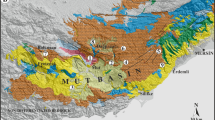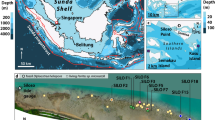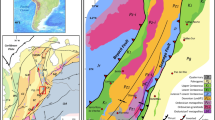Abstract
A program of geophysical mapping and vibracoring was conducted to better understand the geologic evolution of Apalachicola Bay. Analyses of the geophysical data and sediment cores along with age control provided by 34 AMS 14C dates on marine shells and wood reveal the following history. As sea level rose in the early Holocene, fluvial deposits filled the Apalachicola River paleochannel, which extended southward under the central part of the bay and seaward across the continental shelf. Sediments to either side of the paleochannel contain abundant wood fragments, with dates documenting that those areas were forested at 8,000 14C years b.p. As sea level continued to rise, spits formed of headland prodelta deposits. Between ∼6,400 and ∼2,500 14C years b.p., an Apalachicola prodelta prograded and receded several times across the inner shelf that underlies the western part of the bay. An eastern deltaic lobe was active for a shorter time, between ∼5,800 and 5,100 14C years b.p. Estuarine benthic foraminiferal assemblages occurred in the western bay as early as 6,400 14C years b.p., and indicate that there was some physical barrier to open-ocean circulation and shelf species established by that time. It is considered that shoals formed in the region of the present barrier islands as the rising sea flooded an interstream divide. Estuarine conditions were established very early in the post-glacial flooding of the bay.
Similar content being viewed by others
References
Balsillie JH, Donoghue JF (2004) High resolution sea-level history for the Gulf of Mexico since the last glacial maximum. Florida Geological Survey, Tallahassee Rep Investig no. 103
Bandy OL (1954) Distribution of some shallow water foraminifera in the Gulf of Mexico. Washington, DC, US Geol Surv Prof Pap 254-F:125–141
Bock WD (1969) Thalassia testudinum, a habitat and means of dispersal for shallow water benthonic foraminifera. Trans Gulf Coast Assoc Geol Soc 19:337–340
Culver SJ, Buzas MA (1983) Recent benthic foraminiferal provinces in the Gulf of Mexico. J Foram Res 13:21–31
Culver SJ, Grand Pre CA, Mallinson DJ et al (2007) Late Holocene barrier island collapse: Outer Banks, North Carolina, USA. Sediment Record 5:4–8
Donoghue JF (1992) Late Quaternary coastal and inner shelf stratigraphy, Apalachicola Delta region, Florida. Sediment Geol 80:293–304
Donoghue JF (1993) Late Wisconsinan and Holocene depositional history, northeastern Gulf of Mexico. Mar Geol 112:185–205
Donoghue JF, White NM (1995) Late Holocene sea-level change and delta migration, Apalachicola River region, northwest Florida, USA. J Coastal Res 11:651–663
Doyle LJ, Sparks TN (1980) Sediments of the Mississippi, Alabama, and Florida (MAFLA) continental shelf. J Sediment Res 50:905–915
Florida Department of Transportation (1959) State road department, plans of proposed state highway, State Road No. 49580-3601. Eastpoint to St. George Island. Florida Department of Transportation, Tallahassee, FL
Florida Department of Transportation (1979) Project no. 49101-533. Apalachicola River Bridge on U.S. 98. Florida Department of Transportation, Tallahassee, FL
Florida Department of Transportation (1999) Report of core borings, financial project no. 218772-1-52-01. St. George Bridge—S.R. 300 over Apalachicola Bay. Florida Department of Transportation, Tallahassee, FL
Forrest BM (2007) Evolution of the beach ridge strandplain on St. Vincent Island, Florida. PhD Dissertation, Florida State University, Tallahassee, FL
López GI, Rink WJ (2008) New quartz optical stimulated luminescence ages for beach ridges on the St. Vincent Island Holocene strandplain, Florida, United States. J Coastal Res 24:49–62
McKeown HA, Bart PJ, Anderson JB (2004) High-resolution stratigraphy of a sandy, ramp-type margin—Apalachicola Bay, Florida, U.S.A. In: Anderson JB, Fillon RH (eds) Late Quaternary stratigraphic evolution of the northern Gulf of Mexico margin. Tulsa, OK, Soc Sediment Geol (SEPM) Spec Publ 79, pp 25–41
Osterman LE (2003) Benthic foraminifers from the continental shelf 405 and slope of the Gulf of Mexico: an indicator of shelf hypoxia. Estuar Coastal Shelf Sci 58:17–35
Otvos EG (1985) Barrier island genesis—questions of alternatives for the Apalachicola coast, northeastern Gulf of Mexico. J Coastal Res 1:267–278
Parker FL (1954) Distribution of the foraminifera in the northeastern Gulf of Mexico. Bull Mus Comp Zool 111:454–547
Phleger FB (1960) Sedimentary patterns of microfaunas in Northern Gulf of Mexico. In: Shephard FP, Phleger FB, van Andel TH (eds) Recent sediments, northwest Gulf of Mexico. American Association of Petroleum Geologists, Tulsa, pp 267–301
Phleger FB, Parker FL (1951) Ecology of foraminifera, northwest Gulf of Mexico. Part II. Foraminiferal species. Geol Soc Am Mem 46(2):1–64 Boulder, CO
Schnable J (1966) The evolution and development of part of the northwest Florida coast. PhD Dissertation, Florida State University, Tallahassee, FL
Schnable JE, Goodell HG (1968) Pleistocene-Recent stratigraphy, evolution and development of the Apalachicola coast, Florida. Boulder, CO, Geol Soc Am Spec Pap no 112
Stapor FW (1973) Coastal sand budgets and Holocene beach ridge plain development. PhD Dissertation, Florida State University, Tallahassee, FL
Stapor FW (1975) Holocene beach ridge plain development, northwest Florida. J Geomorphol 22:116–144
Twichell DC, Andrews BD, Edmiston L, Stevenson WR (2007) Geophysical mapping of oyster habitats in a shallow estuary: Apalachicola Bay, Florida. Woods Hole, MA, US Geol Surv Open-File Rep 2006-1381
Twichell DC, Pendelton EA, Poore RZ, Osterman LE, Kelso K (2009) Vibracore, radiocarbon, microfossil, and grain-size data from Apalachicola Bay Florida. Woods Hole, MA, US Geol Surv Open-File Rep 2009-1031
Whitfield WK, Beaumariage DS (1977) Shellfish management in Apalachicola Bay: past, present and future. In: Livingston RJ, Joyce EA (eds) Proc Conf The Apalachicola Drainage System, Florida Dept Nat Resources Mar Res Publ no 26, pp 130–140
Faunal list
Ammonia veneta (Schultze, 1854)
Ammonia parkinsoniana (d’Orbigny) = Rosalina parkensoniana d’Orbigny, 1939
Elphidium excavatum (Terquem) = Polystomella excavata Terquem, 1876
Rosalina floridana (Cushman) = Discorbis floridanus Cushman, 1922
Rosalina floridensis (Cushman) = Discorbis bertheloti var. floridensis Cushman, 1930
Author information
Authors and Affiliations
Corresponding author
Electronic supplementary material
Rights and permissions
About this article
Cite this article
Osterman, L.E., Twichell, D.C. & Poore, R.Z. Holocene evolution of Apalachicola Bay, Florida. Geo-Mar Lett 29, 395–404 (2009). https://doi.org/10.1007/s00367-009-0159-1
Received:
Accepted:
Published:
Issue Date:
DOI: https://doi.org/10.1007/s00367-009-0159-1




